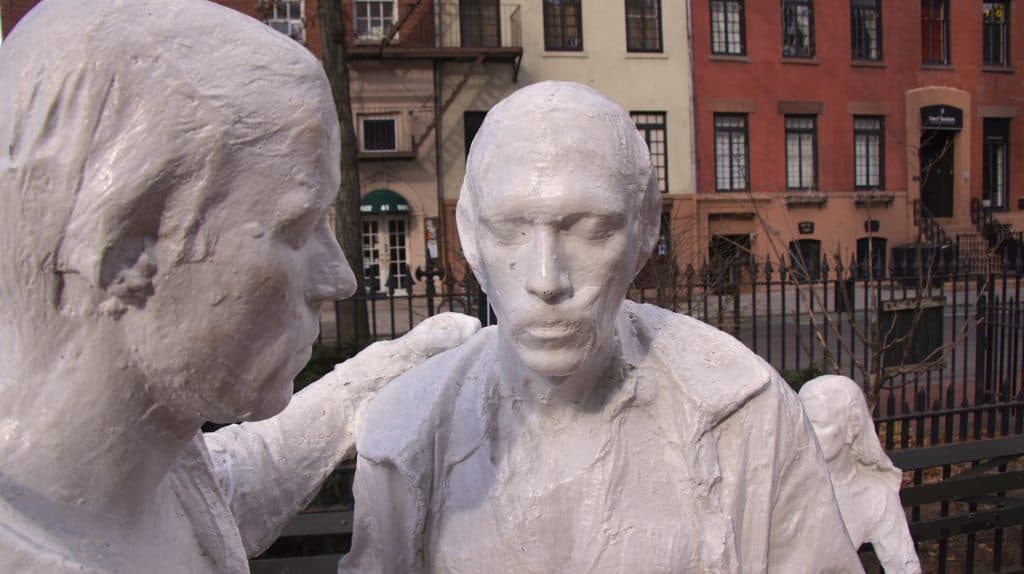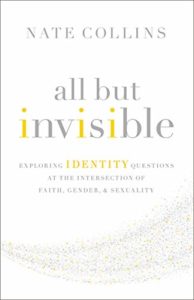
“Everything has a price, son. Just because you don’t have to pay for something yourself doesn’t mean that it’s free.” I’ve had numerous conversations like this with my kids, and they remind me that things that are truly valuable are usually obtained only at high cost. Learning how to incorporate gay people into the life of the church is also costly, because it’s not enough merely to include them. The word inclusion may be a cultural buzzword at the moment, but it doesn’t nearly go far enough. Inclusion is only the beginning of Christian community. Inclusion that cannot express itself through embrace is at best mere apathy, and at worst a sign of cynical tolerance.(1)
In his book Exclusion and Embrace, Croatian theologian Miroslav Volf reflects on the interpersonal dynamics that the four “structural elements” of an embrace signify:(2)
Opening the Arms. Volf notes that open arms are “a sign of discontent with my own self-enclosed identity, a code of desire for the other. I do not want to be myself only; I want the other to be part of who I am and I want to be part of the other.”(3) Volf points out that to do this, the self must create space for the other by stepping back from its own borders, thereby entrusting the boundaries of his selfhood to the other.
This raises several important questions. Do conservative churches truly have their arms open to gay people? Does the posture of traditionalist churches signal not simply a mere openness to the possibility but an actual desire for gender and sexual minorities to be incorporated into their spiritual communities? Are we willing to open ourselves up to the personhood of the gay people in our churches in ways that might change who we are as individual followers of Jesus?
Waiting. According to Volf, waiting “is a sign that, although embrace may have a one-sidedness in its origin (the self makes the initial movement toward the other), it can never reach its goal without reciprocity (the other makes a movement toward the self).”(4) An embrace that cannot restrain the initial desire for the other is violence, not love. A true embrace must wait for the other in a state of vulnerable, exposed openness.
Are we willing to open ourselves up to the personhood of the gay people in our churches in ways that might change who we are as individual followers of Jesus?
Straight Christians with a traditional sex ethic need to be ready and willing to wait—perhaps not long, but maybe longer than expected—for gay people to respond to a newly adopted posture of openness toward them. This is an “I’m in it for the long haul” posture, not a “don’t leave me hanging” attitude. The willingness to wait signals an awareness that Christians cannot make gay people feel comfortable and is an opportunity to cultivate a spiritual atmosphere in which reconciliation can flourish.
Closing the Arms. Volf points out that “in an embrace the identity of the self is both preserved and transformed, and the alterity [otherness] of the other is both affirmed as alterity and partly received into the ever changing identity of the self.”(5) The alterity of the other, or that which makes the other different from me, can sometimes feel threatening. Closing the arms in an embrace paradoxically signals the fact that I am giving up any need I might feel to protect myself from a perceived threat in the other. It is a profoundly vulnerable movement.
More than the first two movements, closing the arms in an embrace communicates to gay people that their humanity has personal value, not simply theoretical value. It signals a willingness to follow through and open oneself up to the personhood of someone, which reflects a desire to be impacted in some positive way by the other.
Opening the Arms Again. Volf claims that “the opening of the arms underlines that, though the other may be inscribed into the self, the alterity of the other may not be neutralized by merging both into an undifferentiated ‘we.’”(6) Opening the arms at the end of an embrace affirms the otherness of the other even as it signals the return of the self “back into itself so that its own identity, enriched by the traces that the presence of the other has left, may be preserved.”(7)
When I reflect on these four elements of an embrace, the first word that comes to mind is vulnerable. When we embrace another, we assume a posture of vulnerability because our souls are exposed. To be honest, this posture terrifies many gay people who grew up attending conservative churches. Rather than being vulnerable, these people learned to hide behind a mask to cope with the shame and guilt associated with their orientation. How wonderful might it be if straight people learned how to assume this posture of vulnerable openness to the personhood of the gay people in their lives? I suspect it would change everything.
Nate Collins (PhD, The Southern Baptist Theological Seminary) has served as an instructor of New Testament Interpretation at The Southern Baptist  Theological Seminary and is currently a partner associate at The Sight Ministry, a Christian organization based in Nashville, Tennessee, that provides resources and support for individuals, families, and Christian organizations regarding LGBT issues. Speaking from his experience as a married, gay man who is a husband, father, and follower of Christ, he is a vocal proponent of extending and receiving community with LGBT individuals both inside and outside the church. Nate has been married to his wife, Sara, for thirteen years, and they have three children. This article is taken from All But Invisible by Nate Collins. Copyright (c) 2017 by Nathan Collins. Used by permission of Zondervan, www.Zondervan.com.
Theological Seminary and is currently a partner associate at The Sight Ministry, a Christian organization based in Nashville, Tennessee, that provides resources and support for individuals, families, and Christian organizations regarding LGBT issues. Speaking from his experience as a married, gay man who is a husband, father, and follower of Christ, he is a vocal proponent of extending and receiving community with LGBT individuals both inside and outside the church. Nate has been married to his wife, Sara, for thirteen years, and they have three children. This article is taken from All But Invisible by Nate Collins. Copyright (c) 2017 by Nathan Collins. Used by permission of Zondervan, www.Zondervan.com.
Notes:
1. I should perhaps point out that a gay person who continues to adhere to a conservative sex ethic and communicates a desire to be included and embraced at a conservative church is already paying a price of sorts. The cultural cost of this decision pales in comparison with the spiritual blessing and eternal reward received on the other side of obedience, but it is a real cost nonetheless. If the individual does not feel called to pursue a mixed-orientation marriage, the decision to remain in the covenant community of a traditional church represents a commitment to lifelong celibacy.
2. Miroslav Volf, Exclusion and Embrace: A Theological Exploration of Identity, Otherness, and Reconciliation (Nashville: Abingdon, 1996), 141.
3. Ibid.
4. Ibid., 143.
5. Ibid.
6. Ibid., 144.
7. Ibid.


